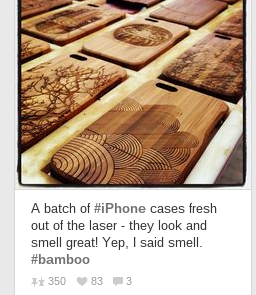@jacktyler_co_uk I had not thought about the heat-dispersing qualities of aluminum, but now that you mention it, I can see how there could be a problem. Then again, the aluminum surface of Dibond is only 0.3mm, so I wonder how much heat it would really absorb. The 3A site does not mention lasers as a processing technique.
When I typed the comment, I had been more concerned with the potential of delaminating the aluminum from the polyethylene core, or melting the core out. I would think that in terms of simply marking the aluminum surface, the GF should do alright… the promo video does show it engraving an aluminum macbook case, right? Presumably the electronics underneath are still functioning…
I had not even thought about adding an additional coating to burn off, that could yield some interesting results. Dibond and the like come “pre-finished”; “coil-coated paint or brushed metal”. Surely that coating can be removed with the GF.
I was wondering more about the “routing and folding” technique of processing dibond. I have used a router, a table-saw, a jigsaw, a press-brake, and even had luck using a #11 blade (scoring lightly, over and over and over) with dibond and alumacor (a similar product with a corrugated plastic center instead of polyethylene). These methods all take time, make noise and waste, and rely on a steady hand paired with well-executed measurements. It sure would be neat to be able to contour-cut/score/engrave that stuff without spreading aluminum and p.e. chunks all over my workshop.
@dan have you tried any kind of ACM yet?
-edit-
After more research into this, I think that I may have been confused by terminology. Etching, engraving, marking…
Am I correct, now, in thinking that the macbook cover-designs in the initial video are “markings” not “etchings” or “engravings”? That the anodized aluminum has been “discolored” by the GF’s laser to create the design? And that the surface would still feel smooth to the touch? And that this was done without any sort of additional coating being applied to the macbook?
If so, I believe that I would be able to mark dibond, but not actually cut into it in any way. Does this seem correct to anyone?
 I know everyone is going to want to make your bag]
I know everyone is going to want to make your bag]